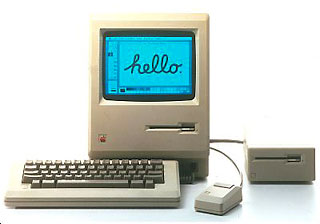
My parents bought me my first computer in 1984. It was the original 128K Macintosh. According to the sales guy, they'd already sold out of their first shipment, and more were back ordered. So I had to spend an agonizing six weeks waiting for my computer. I spent it reading and rereading the first issue of Macworld magazine--pictured here, a copy of which I still have in my closet.
My Mac came with a keyboard and a mouse. It had 128K of memory, and a 400K 3.5" floppy drive. We also bought a dot matrix printer in the matching Apple Beige of the era. The whole thing was $3,500. That's $6,922 in today's dollars (thanks Mom!)
I also got Microsoft Basic for the computer. This was back when Microsoft was known for their programming languages, and had only just started selling

MS-DOS a couple of years prior. I still have my old Microsoft Basic programming manual in the closet as well.
Now that I think about it, although I programmed almost continuously for the 25 years since I got that computer, I only programmed on the Macintosh on that first machine. Once I started college a couple of years later, I switched to programming Unix, and never went back.
I was an avid Mac user for more than a decade. The university environment where I worked through the late eighties was populated with lots of Macs. I enjoyed many of the capabilities of Macs that were novel for the era such as SCSI, Apple Desktop Bus (the original "USB"), AppleTalk networking, file sharing on LANs, and lots of elegant applications. While I programmed on unix machines, I always used a Mac for telnet (and later xterm), and personal productivity apps.
I used Macs all the way up into my time at JPL. But at JPL we also used a lot of SunOS, Solaris and other unix workstations that blew away the Macintosh in terms of power at the time. The "PC" was still not caught up to the true workstations in those days. And there was another problem--the Macintosh had gone to heck.

The product line was diluted with too many models--only a few of which did anything well. AppleTalk was falling way behind TCP/IP. MacOS was in obvious need of a major overhaul. Macintosh was way too expensive for what you got. And the brand was struggling for respect. Enter Windows NT.
I finally, grudgingly, left Macintosh.
I used PCs for several years. I never loved them like I loved the Macintosh of years previous. The PC was just a nicely priced commodity. That was all. I think the only PC I've ever really respected is a small, relatively light, tough as nails Dell CPix notebook that I've had for 7 years and still use around the house as a web browser. Otherwise, they've all been forgettable throw aways.
For years I've wondered if I'd ever have a chance to use a Mac again. It was hard for me to imagine an employer who would buy one for me. I didn't think I could justify the cost for one for myself--especially when my employers were so willing to buy me a PC notebook I could use at home. I finally bought Monica an iBook a few years back. But that is hers. I still spend my day dealing with Windows.
As Macintosh gained credibility over the past few years, and as they continued to amaze the market with their newfound leadership. I became guardedly optimistic. I found myself working for an increasingly Mac company. Our VP of Engineering had one under his desk. Or corporate IT guys are ex-Apple employees--and carry around MacBooks themselves. Hmmm..
Today I took possession of my new MacBook Pro. While it's a totally different machine, I feel like I did when I sat down with that first Macintosh in 1984. It's like the passion that is common to both an antique Ferrari and its modern offspring. I feel like I've come home.























 In my old age it will be nice to watch as a younger generation of enthusiastic people build powerful applications out of tools provided for them on the internet. And as they do so right from their browser.
In my old age it will be nice to watch as a younger generation of enthusiastic people build powerful applications out of tools provided for them on the internet. And as they do so right from their browser.
